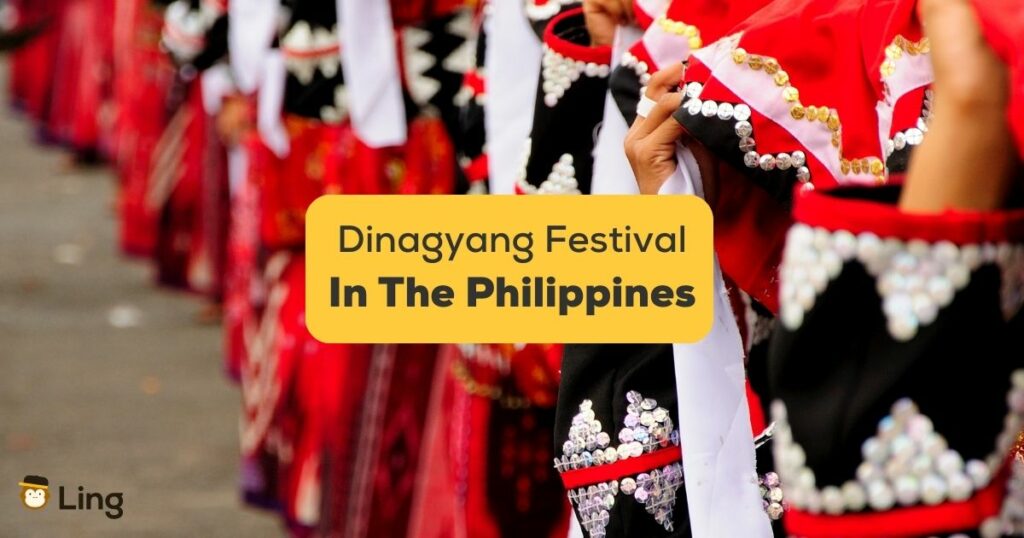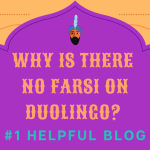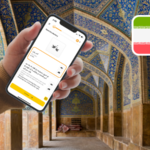The Dinagyang Festival, a kaleidoscope of color, rhythm, and fervor, illuminates the city of Iloilo every fourth Sunday of January. Rooted in both history and spirituality, Dinagyang pays homage to the Santo Niño (the Holy Child Jesus) and commemorates the Barter of Panay, a legendary transaction between early Malay settlers and the Ati people, the indigenous inhabitants of Panay Island. Curious?
Let’s get to know more this unique Pinoy festival and the Tagalog words associated to it in this comprehensive post. Let’s start!
What Is Dinagyang Festival?
At its core, Dinagyang is a synthesis of devotion, gratitude, and vibrant festivity. The name “Dinagyang” is derived from the Hiligaynon word ‘Dagyang,’ which means to make merry. And indeed, the festival lives up to its name, bringing the streets alive with synchronized drum beats, captivating dance routines, and participants adorned in colorful, intricate costumes that emulate the traditional attire of the Ati tribe.
Held right after the Sinulog in Cebu, this festival has religious undertones, with various events centered around the veneration of the Santo Niño, it also serves as a cultural exposition. It showcases the richness of Ilonggo history, arts, and traditions. Sounds pretty cool, right? Let’s get to know more about it in the sections below!
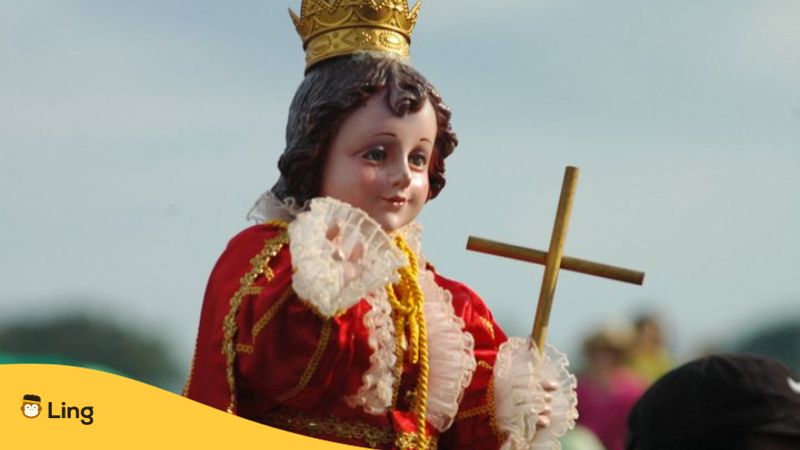
History Behind Dinagyang Festival
Originating as a religious tribute to Santo Niño (the Holy Child Jesus), the festival has interwoven elements of history, particularly the Barter of Panay. This legendary event speaks of the bartering between Malay settlers and the Ati people, the original inhabitants of the Panay Island.
According to local lore, around the 13th century, a group of ten Malay chieftains, often referred to as the “Datus,” fled the tyranny of Sultan Makatunaw from Borneo. Seeking refuge and a new place to settle, they ventured into the central part of the Philippine archipelago. Their search led them to the Panay Island, where they were captivated by its lush landscapes and abundant resources.
Eager to establish their settlement on the island, the Datus proposed a barter or trade with the Ati chieftain, Marikudo. The terms of the exchange were straightforward: the Datus offered Marikudo a variety of items including a solid gold salakot (a traditional hat), brass basins, and long cloth in exchange for the lowlands of the island where they wished to settle. Marikudo agreed to the terms, relocating his tribe to the mountains and higher grounds, allowing the Malays to inhabit the lowlands.
This seemingly simple transaction had profound implications. It signified the merging of two cultures and the peaceful coexistence of the Malay settlers with the indigenous Ati people. As years passed, the cultures integrated, giving birth to a unique blend of traditions, beliefs, and practices that laid the foundation for the vibrant Ilonggo culture we recognize today.
The Dinagyang Festival, with its vibrant Ati-Atihan contest, serves as a tribute to this momentous event. By commemorating the Barter of Panay, the festival not only celebrates the unity and harmony between different ethnicities but also underscores the significance of mutual respect, understanding, and peaceful coexistence in shaping the history and culture of a region.
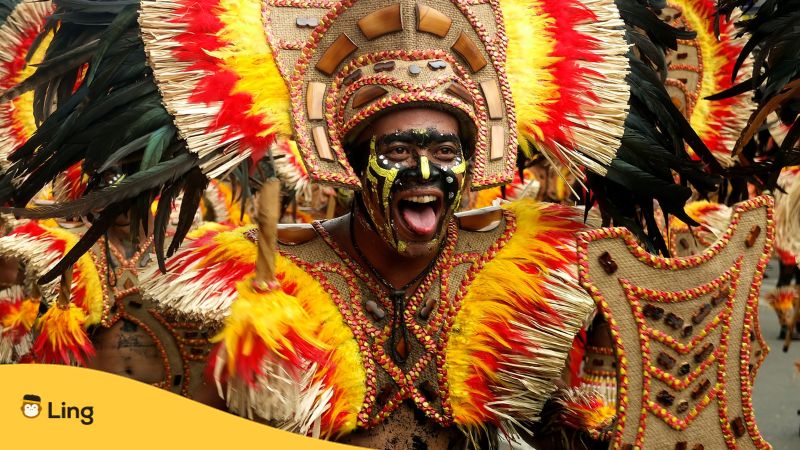
When Is Dinagyang Festival Celebrated?
The festival is celebrated every year on the fourth Sunday of January. While this specific day marks the pinnacle of celebrations, events and activities commence days, sometimes even weeks, in advance. Leading up to the main event, the streets of Iloilo come alive with various preliminary competitions, parades, and religious activities, culminating in the grand Ati-Atihan contest on the festival’s main day.
The January timing is significant as it aligns with the Feasts of the Santo Niño (Holy Child Jesus) celebrated across the Philippines. In Iloilo, this devotion to the Santo Niño intertwines with the historical commemorations of the Barter of Panay, resulting in the unique and grand Dinagyang Festival.
The choice of January also ensures that the festival occurs during a relatively cooler month in the Philippines, making it conducive for participants and spectators to enjoy the outdoor events. The pleasant weather, combined with the festival’s cultural and religious significance, ensures a large influx of visitors, making Dinagyang one of the most attended festivals in the Philippines.
How Is Dinagyang Festival Celebrated?
The Dinagyang Festival is rooted in the devotion to the Santo Niño. The celebrations commence with a series of religious activities. The most significant of these is the fluvial procession where a revered image of the Santo Niño is paraded along the river, accompanied by a convoy of boats, each decorated intricately. Following this, a grand foot procession winds its way through the streets of Iloilo. These processions culminate in a high mass, where thousands gather to offer their prayers and show their reverence to the Holy Child Jesus.
After that, it’s time for the dance competition. The Ati-Atihan dance competition is the highlight and most-awaited segment of the festival. Tribes, their members painted in hues representing the indigenous Ati people, compete against one another in vibrant dance routines. Accompanied by pulsating drum beats, these dances narrate stories of Panay Island’s past, the Barter of Panay, and the harmonious coexistence of the Ati tribe with Malay settlers. The costumes, often handcrafted, display intricate designs and patterns, showcasing the craftsmanship of the Ilonggo people.
Another important event is the Kasadyahan Cultural Parade. Unlike the Ati-Atihan, this parade celebrates the diverse cultural heritage of the region. Various groups and provinces participate, displaying their unique dance forms, folklore, and traditions. It’s a visual treat that educates spectators about the multifaceted culture of the Western Visayas region.
As evening dawns, Iloilo’s streets turn into avenues of celebration. Street parties, live music events, and night markets spring to life. Locals and tourists alike mingle, savoring the local cuisine, shopping for crafts, and dancing to the infectious beats played by local bands and DJs.
Tagalog Words Related To The Dinagyang Festival
While Dinagyang Festival is predominantly celebrated in Iloilo and is closely tied to the Hiligaynon language and culture, its prominence has made it familiar across the Philippines. As such, there are Tagalog words and terms associated with or that can describe facets of the festival. Here’s a list of Tagalog words and their English translations that relate to the Dinagyang Festival.
| English | Tagalog |
|---|---|
| Festival | Pista |
| Dance | Sayaw |
| Music | Tugtog |
| Costume | Kostyum |
| Parade | Parada |
| Devotion or Vow | Panata |
| Culture | Kultura |
| Heritage or Legacy | Pamana |
| History | Kasaysayan |
| Celebration | Pagdiriwang |
| Merriment or Joviality | Kasadyahan |
| Tribe | Tribo |
Learn Tagalog With Ling
As we learned in this post, the Dinagyang Festival is more than just a spectacle. It is a vivid representation of the resilience, creativity, and unity of the Filipino people. Through dance, music, and art, the festival immortalizes the harmonious blend of indigenous and foreign cultures that make up the Philippines’ unique identity.
To truly immerse oneself in the depth and beauty of Filipino traditions, understanding the local languages, especially Tagalog, offers an invaluable perspective. For those intrigued and wishing to delve deeper into the language, downloading the Ling app from the App Store or Play Store is a great starting point. Embrace the world of Tagalog and connect more intimately with the heart and soul of Filipino festivals like Dinagyang.
